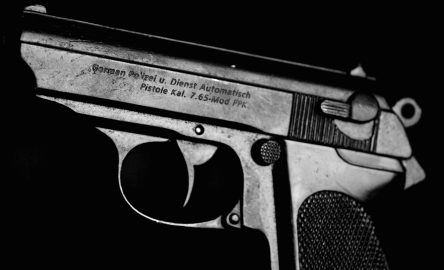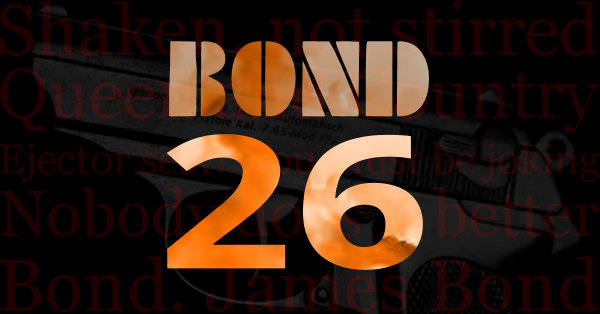A look at the gun James Bond is most associated with – the Walther PPK.

In Dr No James Bond is met with orders from the armourer to hand over his Beretta .25 semi-automatic. In its place he recommends switching to the Walther PPK, a 7.65 mm semi-automatic pistol “with a delivery like a brick through a plate glass window.”
While Bond would employ other firearms as circumstances dictated, the Walther PPK became his principal side arm, and joined the “shaken, not stirred” martini as one of the quintessential props of the character.
Although over the years Bond has sometimes used other firearms, including Walther’s P5 and the heavier P99 9mm, it is the PPK to which he keeps returning. Both Bond fans and the general cinema-going public still identifies the PPK as the pistol of choice for Commander Bond.
History of the PPK
The Walther company, based in Germany, has a long history in the firearms industry. Founded in 1886 by Carl Walther, the company initially specialized in the production of hunting and sporting rifles. However, it was not until the mid-20th century that Walther began to establish itself as a major player in the world of pistols.
The Walther PPK first entered service in 1931, as an evolution of Walter’s popular Polizeipistole, or PP. That was first introduced in 1929 as a police pistol and quickly gained popularity among police forces in Europe. It was designed with innovative safety features, including an automatic hammer block and a loaded chamber indicator, with a hinged trigger guard to allow for easy disassembly.
PPK stands for Polizeipistole Kriminal (“police pistol criminal”) and was expressly meant for use by plainclothes policemen and detectives and was the first firearm designed specifically for concealed carry. Such work demanded a smaller firearm that could be easily concealed and would not attract attention. This was achieved by making its grip frame and barrel shorter and reducing its magazine capacity. One key feature was the double-action/single-action trigger that decocks when the safety is rotated down into the safe position, which made it a popular choice among those who needed a reliable and concealable firearm.
The PPK also stands out for its unique design, featuring a beavertail grip and a hinged trigger guard. The beavertail is the protrusion at the back of the grip above the hand and is more than just a design feature. When you shoot a pistol, the recoil can cause the slide to move backward quickly, which can injure your hand if it gets in the way. The PPK’s beavertail ensures your hand stays clear of the slide and also helps you get a better grip, which makes it easier to aim accurately.
The hinged trigger guard is a clever design that allows the slide to be unlocked and moved backwards past its normal stopping point by pulling the trigger guard downwards. This makes it easy to clear the barrel and remove the blowback spring for maintenance or cleaning.
It was a reliable and compact automatic pistol at a time when there were few designs that were either, and became an instant success. The handgun saw widespread use with German police and the Luftwaffe and its success led to a partnership between Walther and the German military during World War II, during which Walther produced the P38 pistol for the German army. Indeed it was with a PPK that Adolf Hitler shot himself in 1945.
Following the war, Walther shifted its focus to producing sporting and recreational firearms, though it continued to produce the PPK and other handguns. It was reportedly used by various intelligence agencies around the world, including the CIA, French Intelligence and Mossad. Its small size and reliable performance made it a favourite among and covert operatives who needed an accurate, dependable firearm that could be easily concealed.
Today, the Walther company remains a major player in the firearms industry, with a reputation for quality and precision that has made its pistols popular with law enforcement, military, and civilian users alike. The PPK has undergone several modifications and variations, including the PPK/S which is slightly heavier and longer with a larger magazine capacity, and the PPK/E which features a lighter frame.
Aside from its popularity in pop culture, the PPK has been extensively utilized by military forces and law enforcement agencies worldwide. Its compact size and effectiveness in close-quarters combat have also made it a popular choice for civilian concealed carry and self-defence. Despite being an old model, the PPK remains a highly regarded and desired firearm.
Bond adopts the PPK
The PPK found its way into Bond’s hands based on a bit of fan correspondence. Geoffrey Boothroyd first wrote to Ian Fleming in 1956, shortly before the publication of From Russia, With Love.
He told Fleming that he loved the novels, but hated Bond’s choice of weapons and the Beretta .25 in particular, an easily concealed pocket pistol with the drawback of shooting a very light round – a “lady’s gun”, Boothroyd informed Fleming. He suggested that the PPK would be a better choice. It was only slightly larger, packed more of a wallop, and the ammunition for it was in widespread use.
This was one of several firearms criticisms that resulted in Boothroyd becoming the basis for the armourer, the character who developed into the much loved Q of the movies.
The first was a Centennial Airweight revolver which Bond could carry in a Berns-Martin Triple Draw holster, and the second was a .357 Magnum revolver with a 6½ inch barrel, which Bond could keep in his car. You can read more about Boothroyd’s involvement here.
At the end of From Russia, With Love Bond’s silencer snags on his clothing and he almost dies as a result. Because of that at the beginning of Dr No M asks the armourer to recommend a new weapon to Bond. He ranked the gun fourth in a a weapons test, placing it behind the Japanese M-14, Russian Tokarev, and Sauer M-38 but praised it for its light trigger pull and its ability to obtain ammunition worldwide – that was not the case for the Japanese and Russian firearms, although it is unclear why the armourer rejects the Sauer.
Furthermore, the armourer recommends that Bond switch from his chamois leather shoulder holster to a Berns-Martin holster. However, it should be noted that Fleming was incorrect in stating that the Berns-Martin holster was suitable for holding a pistol; it is actually designed for revolvers.
Taking its cues from the book, the first James Bond film saw 007 being stripped of his Beretta and being equipped with a Walther PPK in its place, although it should be noted that the gun that appeared on screen was in fact a 9mm Walther PP.
While Bond has tended to be armed with the 7.65mm calibre gun holding seven rounds of ammunition (also known as .32 ACP), a 9mm calibre PPK is also available holding six rounds (.380 ACP). In The Man with the Golden Gun as Bond quizzes Scaramanga about his firearm’s magazine capacity: “Six bullets to your one?” That implies that Bond is using the 9mm version of the Walther PPK.
And in Skyfall Bond was equipped with the slightly larger Walther PPK/S. It can hold eight rounds of 7.65mm ammunition, compared to the PPK’s capacity of seven rounds.
The Walther PPK, as originally manufactured, did not meet the requirements of the Gun Control Act of 1968 due to its small size and short barrel length. The act set minimum size and barrel length requirements for handguns in order to limit their concealability, and the PPK did not meet these requirements. As a result, the PPK was effectively banned from importation into the United States.
The answer was the PPK/S, which features a combination of the frame of the PP with the barrel and slide of the PPK. As well as 7.65mm and 9mm calibre variants a .22 calibre PPK/S is also available with capacity expanded to ten rounds.
Guns have changed a lot since Ian Fleming wrote Dr No. Pierce Brosnan carried a Walther P99 in The World is Not Enough and Die Another Day, which is slightly longer than the original PP and carries more ammunition. Except for the pre-title sequence, Daniel Craig continued with the P99 in Casino Royale. However, it is still a Walther semi-automatic that sits in Bond’s shoulder holster and he reverted to the PPK in Quantum of Solace. Despite other handguns appearing in Craig’s remaining films, the PPK always makes an appearance.










